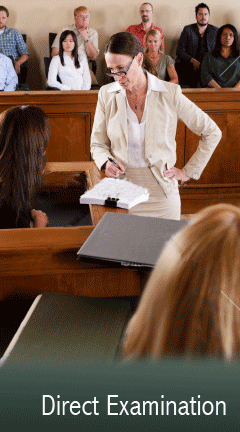Archival Notice
This is an archive page that is no longer being updated. It may contain outdated information and links may no longer function as originally intended.
Home | Glossary | Resources | Help | Course Map
The design of the direct examination of an expert witness is governed by two factors:
- The jurisdiction's governing laws or evidence code, which may place limits on how the expert testimony is offered.
- The skill of the lawyer in crafting an interesting presentation.
Evidence codes, such as the federal rules of evidence, often place restrictions on the method and scope of expert opinion testimony. One such limit applies to whether or not an opinion may be given without the expert first describing all of the underlying facts in detail.
The Federal Rules of Evidence permit the opinion to come first, stating that "[t]he expert may testify in terms of opinion or inference and give reasons therefore without first testifying to the underlying facts or data, unless the court requires otherwise" (FRE 705). Other jurisdictions may require the expert to first state the underlying facts or research, and only then explain the opinion to which those facts lead.
A second and significant limitation applies to whether and when an expert may repeat information from third parties (hearsay). The law recognizes that the expert often does not work alone. Instead, the forensic analyst confers with colleagues, or bases conclusions on patient interviews or similar sources of data.
As long as this third-party information is of the type upon which experts in the relevant field normally rely, there is no problem with the opinion or conclusion itself. However, it is one thing to base an opinion on what others have said, and quite another to simply repeat what the third parties said. The latter directly implicates the concerns underlying the rule that prohibits hearsay evidence (see Trial, Topic 5: Pretrial Motions: Motions in Limine and Hearsay).
Additional Online Courses
- What Every First Responding Officer Should Know About DNA Evidence
- Collecting DNA Evidence at Property Crime Scenes
- DNA – A Prosecutor’s Practice Notebook
- Crime Scene and DNA Basics
- Laboratory Safety Programs
- DNA Amplification
- Population Genetics and Statistics
- Non-STR DNA Markers: SNPs, Y-STRs, LCN and mtDNA
- Firearms Examiner Training
- Forensic DNA Education for Law Enforcement Decisionmakers
- What Every Investigator and Evidence Technician Should Know About DNA Evidence
- Principles of Forensic DNA for Officers of the Court
- Law 101: Legal Guide for the Forensic Expert
- Laboratory Orientation and Testing of Body Fluids and Tissues
- DNA Extraction and Quantitation
- STR Data Analysis and Interpretation
- Communication Skills, Report Writing, and Courtroom Testimony
- Español for Law Enforcement
- Amplified DNA Product Separation for Forensic Analysts


